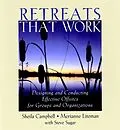Retreats That Work is a practical, easy-to-use guide, full of step-by-step instructions for leading a wide variety of tested exercises. You'll learn how to design and facilitate retreats that will keep participants energized and on-task. Campbell and Liteman know what can go wrong at a retreat and what to do about it. They know how to turn difficult situations around and how to deal effectively with conflict, difficult participants, and resistance to change. With Retreats That Work, you will too.
Autorentext
Merianne Liteman and Sheila Campbell design and lead
offsite retreats for organizations worldwide. Their clients include
Mitsubishi Electric America, the Boston Museum of Fine Arts, Fannie
Mae, National Geographic Television, the U.S. Department of State,
Goodyear Tire and Rubber Co., the U.S. Military Academy at West
Point, and Kodak.
Klappentext
Whether you're an executive who wants to hold a retreat or a facilitator who will design and lead it, Retreats That Work is a comprehensive handbook for creating offsites that get results and rave reviews from participants.
Retreats That Work is a practical, easy-to-use guide, full of step-by-step instructions for leading a wide variety of tested exercises. You'll learn how to design and facilitate retreats that will keep participants energized and on-task. Campbell and Liteman know what can go wrong at a retreat and what to do about it. They know how to turn difficult situations around and how to deal effectively with conflict, difficult participants, and resistance to change. With Retreats That Work, you will too.
Whether you're a seasoned professional or a first-timer, Retreats That Work is required reading, destined for a life of dog ears and highlighted passages, as you turn to it again and again for its valuable insight and advice.
Inhalt
Acknowledgments.
Introduction.
SECTION ONE: The Convenor?s Guide to Ensuring a Successful Retreat.
Chapter 1. So You?re Thinking of Holding a Retreat.
Nine Reasons to Hold a Retreat.
Guiding Principles for Retreat Design.
Ten Reasons Not to Hold a Retreat.
Kinds of Retreats.
Who?s Who in Planning a Retreat.
Chapter 2. Setting the Goals, Deciding the Format, and Inviting the Participants.
Last Things First?What Do You Want to Be Different?
Who Should Facilitate?
Whom Should You Invite?
Using a Specialized Retreat Format.
Involving Participants in Retreat Planning.
Chapter 3. Planning Retreat Logistics.
How Long Should a Retreat Last?
When Should You Schedule Your Retreat?
Where Should You Hold Your Retreat?
Sleeping Rooms and Meals.
Sports and Recreation.
Notifying Participants.
Chapter 4. The Role of Leaders at the Retreat.
Reaching an Understanding About Participants? Authority.
Leadership Behavior During the Retreat.
A Common Post-Retreat Concern.
SECTION TWO: The Facilitator?s Guide to Designing and Planning the Retreat.
Chapter 5. Retreat Design Issues.
Aligning Yourself with the Convenor.
Pre-Retreat Interviews with Participants.
Identifying the Scope of Issues and Creating the Retreat Plan.
Capturing the Work Product.
Using Behavioral Assessments.
Pre-Work for Retreat Participants.
Using ?White Space?.
Thinking About Logistics.
Sins of Omission: The Top Ten Retreat Design Mistakes.
Special Design Considerations for Board Retreats.
Design Issues for a Series of Retreats.
Chapter 6. Retreat Design Components.
Introduction.
Ground Rules.
Individual Check-In.
Giving Feedback to the Group.
Content Segments.
Decision Making.
Action Planning.
Closing.
SECTION THREE: The Facilitator?s Guide to Leading the Retreat.
Chapter 7. Leading the Retreat.
Process or Content Facilitator?
When Should the Facilitator Intervene?
Giving Feedback to Retreat Participants.
Working with Co-Facilitators.
For Internal Facilitators: Partnering with Another Facilitator.
Diversity Issues at the Retreat.
Encouraging Participation.
Changing the Plan.
Chapter 8. Helping Participants Make Decisions and Plan for Action.
Methods of Decision Making.
Types of Retreat Decisions.
The Nub: Action Planning.
Chapter 9. How to Recover When Things Go Awry.
A Few Participants Dominate the Discussions.
The Group Keeps Wandering Off Task.
The Group?s Energy Is Flagging.
A Participant Keeps Plowing the Same Ground.
A Participant Repeatedly Disrupts the Conversations.
A Senior Manager Violates the Ground Rules.
People Are Misusing Humor.
A Participant Is Overtly Hostile or Refuses to Participate.
?I?m Outta Here?: A Participant Walks Out.
The Boss Gets Furious or Bursts into Tears.
Participants Are Resisting New Ideas.
An Intense Conflict Breaks Out.
A Participant Breaches Another?s Confidence.
SECTION FOUR: The Facilitator?s Activity Manual.
Chapter 10. Leading a Strategic Planning Retreat.
Elements of Organization Strategy.
Mission, Vision, or Purpose?
Activity: Exploring Strategic Purpose.
Discerning the Organization?s Values.
Activity: Looking at Our Values.
Understanding the Environment.
Activity: Glimpses into the Future.
Activity: Rating Resources.
Activity: Our Stable of Clients or Resources.
Activity: Prioritizing Constituencies.
Activity: Distinctive Competencies.
Evaluating Work Processes.&...
